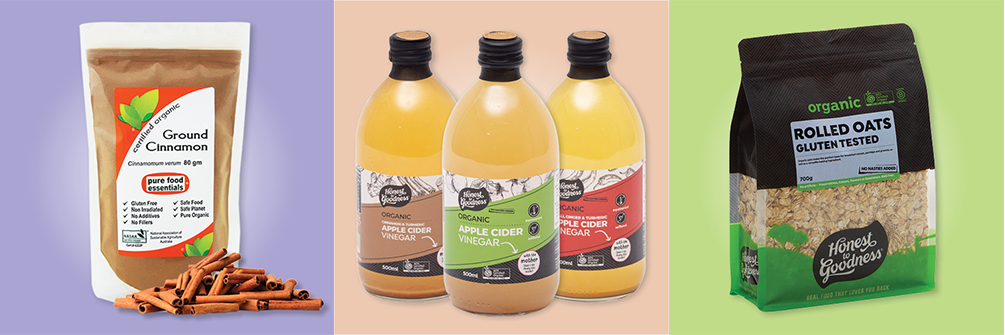Have you ever thought about giving up sugary food like cakes and lollies but never had the motivation? They why not take on the Sugar Free September Challenge! Now’s the time to do something positive for yourself, and for others. Your efforts will give SWEET opportunities to kids and adults living with the devastating impacts of Muscular Dystrophy.
Each year Muscular Dystrophy NSW (MDNSW) hosts their Sugar Free September Challenge to educate Australians about healthy eating and lifestyle changes, while also raising funds for their Muscular Dystrophy community.
We have teamed up with MDNSW as one of their prize donors and our talented team member Claudia Wilson who studied nutritional and dietetic medicine, has put together a 7 day meal plan to help you get started with this year's challenge! Read on for her top tips on how to manage sugar in your diet!
WHAT IS SUGAR?
Sugars are carbohydrates the body converts to glucose. Glucose is used as the main source of energy for the body’s cells. Insulin is a hormone excreted from the pancreas that moves glucose from the blood to cells to be used as energy. Consuming sugars in excess over long periods of time can cause insulin resistance leading to diabetes.
When blood sugars are low this can cause fatigue as the body’s cells are lacking energy – this is a big cause of the ‘3 pm slump’. Having low GI meals and snacks such as our Keto Trail Mix can help avoid this by keeping blood sugar levels consistent, avoiding spikes and crashes.
To put it simply, there are two types of sugars – simple and complex.
Simple/refined sugars are digested and absorbed faster, causing a higher spike in blood glucose levels. Top sources of simple sugar foods include white bread, white flour, cakes, pastries, cereals and table sugar.
Complex sugars take longer to digest, therefore help with satiety and generally contain more fibre assisting in regulating blood sugar levels and acting as a prebiotic. Examples of complex sugars/carbohydrates include fruit, vegetables, whole grains, and legumes.
ALTERNATIVE SUGARS
Sugar alternatives such as stevia, monk fruit and xylitol contain <0.2mg of sugar per 100g. These sugars are metabolised differently and do not have the same effect on blood glucose levels.
Other natural sweeteners such as Organic Brown Rice Syrup and Coconut Flower Nectar do contain sugar. However, they are lower GI, meaning the sugar is slower to digest and absorb causing a slower rise in blood glucose.
TIPS FOR REGULATING BLOOD SUGAR LEVELS
CHECK LABELS ON PRODUCTS
Check labels for sugars such as high-fructose corn syrup, juice concentrates, sucrose, glucose, fructose, dextrose. These sugars are added and not naturally occurring like the sugar in fruit and milk. Check the nutrition panels for total sugars per 100g combined with fibre content. This can give a good indication on the sugar content and glycaemic index (GI) of the product. Many products with added sugars include – sauces, cereals, sweetened beverages, chips, and chocolate.
FULL-FAT PRODUCTS
Many low-fat products will have a higher sugar content in order to make up for the flavour. However, the increase in sugar will increase the calories in the product and affect weight gain more than a full-fat product would have.
SWAPS
Swap higher GI products for alternatives such as ketchup for a homemade tomato sauce or salsa, muesli bar for a handful of nuts, or milk chocolate for dark chocolate. This can fulfil cravings while staying fuller and satisfied for longer.
SLEEP
Sleep is important for regulating stress levels and hunger hormones leptin and ghrelin. When these hormones are imbalanced + you do not wake up feeling refreshed, people are more likely to crave snacks high in sugar to compensate for low energy levels.
INGREDIENTS TO STABILISE BLOOD SUGAR LEVEL

These foods are simple additions to your diet that can help stabilise blood sugar levels.
CEYLON CINNAMON
Ceylon cinnamon Increases insulin activity and acts similar to insulin by enhancing glucose transport. This helps in reducing and stabilising blood glucose levels.
APPLE CIDER VINEGAR (ACV)
Consuming 1-2 tbsp Organic Apple Cider Vinegar daily can increase insulin sensitivity and improve the body’s absorption of sugars.
CRUCIFEROUS VEGETABLES (E.G BROCCOLI, CABBAGE, BOK CHOY, ROCKET)
A simple plate of cruciferous veggies contain the highest source of chromium. Chromium is a nutrient that can assist in controlling blood sugar levels and stabilising energy. Cruciferous vegetables also contain sulforaphane, a compound assisting in lowering blood sugar levels.
WHOLEWHEAT GRAINS (E.G. OATS, BARLEY, SORGHUM, RYE)
Wholewheat grains contain beta-glucan, a fibre that aids in regulating blood sugar levels, increases satiety (the feeling of being full) and stabilises absorption of sugars. Oats and Barley also contain chromium.
PROTEIN
Including protein in meals increases satiety and slows down the absorption of sugars assisting in stabilising blood glucose. Aim for 20-30g of protein per meal.
WHOLEFOODS
Wholefoods are higher in fibre. Fibre stabilises blood sugar levels by slowing the release of sugars into the bloodstream. Aim for 20-30g fibre a day.




![Introducing Euclove – Our New Natural Cleaning [Supplier Spotlight] Introducing Euclove – Our New Natural Cleaning [Supplier Spotlight]](https://cdn11.bigcommerce.com/s-dis4vxtxtc/images/stencil/160w/uploaded_images/euclovethumbnail.jpg?t=1752205799)



